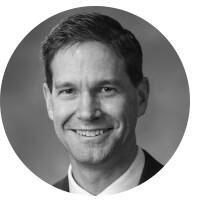So, John, the question would then come up, I think, for many people in the church—of the actual symbol of the cross itself. Why? Why would we not have that on our churches? Is there a difference between Christianity vs Mormonism? Now, that’s a great question. And it probably deserves a whole broadcast in itself, but the short version is: what’s interesting is if we were to go back to the time of Joseph Smith, the cross was not the symbol of Christianity. Methodists, Baptists, most Protestant denominations did not use the cross as a symbol. It was only a Catholic symbol, and there were only five Catholic churches in the whole state of New York in 1820. So, Joseph Smith is growing up in a cultural context where the cross is not a sign of religion, specifically of broader Christianity. And over the following decades, our church has continued the institutional practice of not displaying the cross. And I think one of the things that can be very helpful for us as we interact with the 99 percent of Christians for whom the cross is a symbol of the resurrected Christ is to remember that for many, the cross is the living Christ.
Eric Huntsman published this story. I remember being surprised once when a Presbyterian friend corrected me when I told her that we preferred to worship a living rather than a dead Christ. She responded that she did too. The cross reminded Protestants that Jesus died for their sins, but it was empty because He was risen and no longer there on it. I was chastened by her response, realizing that just as we do not appreciate others mischaracterizing our beliefs, neither should we presume to understand or misrepresent the beliefs and practices of others.
I don’t know what your experiences throughout your life have been, Tyler, but I know that for me, when I was a missionary, if I saw someone wearing a cross, I would kind of automatically think about them as the other, and that’s different. It would feed the idea of how are Mormons different than Christians. Now, I wish I could go back and go to the person like, ‘Hey, I see that you believe in the resurrection of Jesus Christ,’ or ‘I see that you believe in Christ’s atonement for our sins.’ I’ve got this book right here, and it talks in the very beginning about a prophet named Nephi foreseeing Jesus Christ being lifted up upon the cross, and it’s this great common belief that we have. The prophet Jacob in Jacob chapter one said that we should view His death. Mormon said that the death of Christ should rest in our minds forever, and in another place, he says, ‘Behold the wounds.’ It’s Jesus; it’s doctrine (3 Nephi 11:14-15).
So, the living Christ himself is saying, ‘Fix your eyes upon, look at the wounds.’ When Jesus says, ‘Learn of Me,’ He means His whole life, and especially culminating in that most critical part of His life when He’s performing the infinite sacrifice, when the Lamb of God is being slain for the sins of the world, and I’m in you, and we’re all part of this of the world.
Brothers and sisters, He’s not just dying on the cross; He’s suffering for me; He’s suffering for you; He’s suffering for each of us on the cross. This week of Easter, it’s worth some time to maybe dig into Matthew, Mark, Luke, and John, and then the scriptures of the Restoration, to learn of Him, even when it gets a little bit uncomfortable because that price wasn’t just paid in random; that infinite atonement was paid for me and you and us, and to understand what that means and what He went through, understanding once again, it’s an infinite atonement.
And here I am with finite capacity, a finite brain, and for me to be able to understand that, it’s impossible. But with a finite capacity, with the help of the Holy Ghost, I can learn certain elements of what Jesus is going through to enhance that experience so that it becomes much more meaningful for me, so that I appreciate the price that was paid because I understand it better, and the more I understand it, the more I will love Him, the more I love Him, the more I’ll follow Him, and the more I’ll devote my life to Him.
He gave everything for us; He laid it all on the altar, and the more I can learn about what was actually laid on the altar, the more likely I am to lay all that I have back on the altar in return. That’s what unites Christianity vs Mormonism.

By Dr. Tyler Griffin, Source Expert
Dr. Tyler Griffin embarked on his professional journey by teaching seminary courses for a period of six years in Brigham City, Utah. Following that, he dedicated the subsequent seven years to instructing at the Logan LDS Institute, located adjacent to Utah State University. Alongside his participation in the Seminary Preservice program, he spearheaded and supervised the implementation of the online seminary program. Dr. Griffin has been an educator at BYU for well over a decade and holds a co-founding position within the BYU Virtual Scriptures Group. His undergraduate degree is in Electrical Engineering, while both his master’s and doctorate degrees center around Instructional Technology. Dr. Griffin is the exclusive author of “When Heaven Appears Distant” co-author of “Come Unto Me: Illuminating the Savior’s Life, Mission, Parables, and Miracles” and co-editor of “Millions Shall Rediscover Brother Joseph.”

Fact Checked by Mr. Kevin Prince, Source Expert
Kevin Prince is a religious scholar and host of the Gospel Learning Youtube channel. His channel has garnered over 41,000 subscribers and accumulated over 4.5 million views. Mr. Prince also created the Gospel Learning App, a reliable platform where individuals seeking truth can access trustworthy answers to religious questions from top educators worldwide.
About Mormonism Explained
Mormonism Explained is a resource that was designed to provide objective and factual information about Mormonism, its history, doctrines, and policies. Our team of researchers consults experts and primary sources to present factual information on a variety of topics relevant to the Mormon Church.

